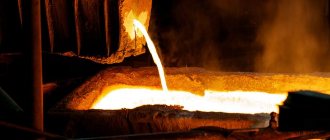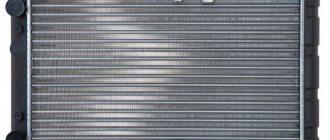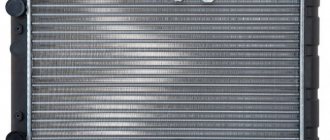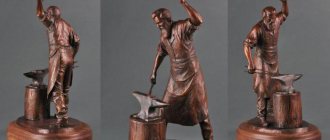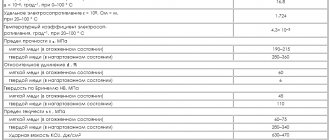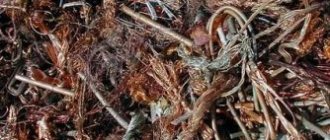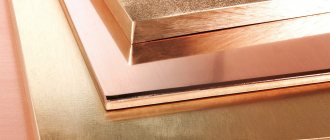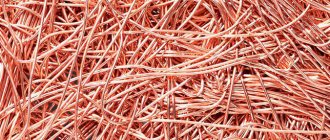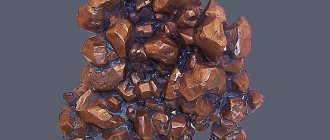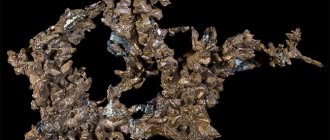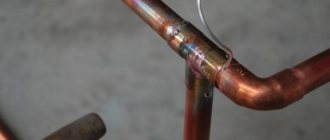What material is called solid copper - Metals, equipment, instructions
Copper is a highly conductive material. These are materials whose resistivity value is less than one tenth of a microohm per meter. For copper, this value is 0.017-0.018 μOhm*m. Copper is also a conductor in terms of electrical properties and a diamagnetic in terms of magnetic properties.
How is copper obtained?
Copper used in wires and cables is of fairly high purity. To obtain it, copper ores (sulfide, oxide and mixed) are used. Let me remind you what sulfide ores are - they are fossil raw materials that are mined in nature and consist of heavy metal (ore), sulfur (sulfide) and various impurities.
Sulfide ores account for almost all copper production and reserves (among ore production). The most common minerals in terms of deposits and feasibility of extraction among sulfide ores are chalcopyrite (CuFeS2), chalcocite (Cu2S), bornite (Cu5FeS4).
name of the mineral chemical formula % copper color
| chalcopyrite | CuFeS2 | 34,5 | gold, yellow |
| chalcocite | Cu2S | 79,8 | black, gray, blue |
| bornite | Cu5FeS4 | 63,3 | red, copper |
In general, in the first stage, copper-containing ores are mined.
The mined ores must then be purified of all impurities and foreign metals to produce copper. For these purposes, the following methods are used: pyrometallurgical, hydrometallurgical and electrolysis. For example, after the pyrometallurgical method we will receive copper ingots in which the copper itself will be 90 percent. Not bad, but it could be better.
Then this blister copper is brought to 99.99% purity using electrolytic purification and we get what is used in the energy industry.
The influence of impurities on the properties of copper
The issue of copper purity is quite important:
- in the presence of 0.02% aluminum impurity, electrical conductivity decreases by approximately 10%. But aluminum is a fairly good conductor.
- in the presence of 0.1% phosphorus, the resistance increases by 55%, therefore the conductivity decreases as the reciprocal of the resistance
- if there is bismuth or lead in copper in an amount of more than 0.001%, then this causes red brittleness (cracking during hot pressure treatment)
- Oxygen in copper makes soldering difficult and increases resistivity. To avoid this, a phosphorus additive is introduced
- hydrogen - forms microcracks and increases brittleness
If several impurities are present, then there are situations where they interact and their influence increases significantly.
For the use of copper to transmit electricity, the presence of impurities has only a negative effect.
Copper grades for electrical engineering and in general
Copper grades consist of the letter “M”, which means copper. This is followed by a number from 0 to 4.
Sometimes one of the letters is then found that characterize the method of producing the metal: k - cathode, p - deoxidized with low residual phosphorus, f - deoxidized with high residual phosphorus, b - oxygen-free. Oxygen-free is M0, and deoxidized is M1. There are many grades of copper, let's look at some:
A special grade of copper is M1E. This is electrical copper, which is produced in the form of tires, rods of various diameters and sections. It can be extra hard, hard, semi-hard and soft. The conductivity of soft copper is a couple of percent higher.
Available in the form of tires, rods, circles. The rods, in turn, have a diameter from 5 to 40 mm and a cross-sectional shape - circle, square, hexagon. This type of copper has a limited shelf life - up to a year for soft copper and six months for hard copper.
Copper alloys in electrical engineering
There are various copper alloys, including bronze, brass and others. Some of them have found application in energy. Let's look at these alloys.
Bronzes are alloys of copper with tin, aluminum, silicon, and lead.
Among other impurities, the highest electrical conductivities are (in order of decreasing electrical conductivity): cadmium, chromium and beryllium bronze.
The most common tin bronze has a low electrical conductivity. Bronze is used for the manufacture of contacts, spring contacts, plates in parts of electrical machines, and high-strength wires.
Brass is an alloy of copper with zinc (these two substances make up the majority of the alloy) and other impurities. The percentage of zinc reaches 43%. Used for spring contacts, plug connectors.
Manganin is an alloy of copper with the addition of manganese and nickel. Used for the manufacture of additional resistors and shunts in measuring technology. If silver is used instead of copper, the electrical properties are improved.
This article provides basic concepts about the use of copper in the energy sector; a more in-depth study is possible by mastering special technical literature on this topic.
Liquid and gaseous dielectrics
SF6 gas
Copper and its alloys
Copper belongs to the group of non-ferrous metals most widely used in industry. The serial number of copper in the periodic system of D.I. Mendeleev is 29, atomic weight A = 63.57. Copper has a face-centered cubic lattice (fcc) with a period a = 3.607 Å.
Specific gravity of copper g = 8.94 g/cm3, melting point - 1083 0C. Pure copper has high thermal and electrical conductivity. The electrical resistivity of copper is 0.0175 μΩ×m, thermal conductivity l = 395 W/(m×deg).
Ultimate strength sв = 200…250 MPa, hardness 85…115 НВ, relative elongation d = 50%, relative contraction y = 75%.
Copper is a non-magnetic metal. It has good manufacturability: it can be processed by pressure, cutting, is easy to polish, is well soldered and welded, and has high corrosion resistance. The main area of application is the electrical industry.
The electrical conductivity of copper is significantly reduced in the presence of even very small amounts of impurities. Therefore, especially pure copper M00 (99.99%), electrolytic copper M0 (99.95%), and M1 (99.9%) are used as conductor materials. Technical copper grades M2 (99.7%), M3 (99.5%), M4 (99.0%).
Depending on the mechanical properties, a distinction is made between hard, cold-worked copper (MT) and soft, annealed copper (MM).
Harmful impurities in copper are bismuth, lead, sulfur and oxygen. The action of bismuth and lead is similar to the action of sulfur in steel; They form low-melting eutectics with copper, located along the grain boundaries, which leads to the destruction of copper when it is processed under pressure in a hot state (the melting point of the eutectic is 270 0C and 326 0C, respectively).
Sulfur and oxygen reduce the ductility of copper due to the formation of brittle chemical compounds Cu2O and Cu2S.
Technically pure copper is rarely used as a structural material, since it has low strength properties and hardness. The main copper-based structural materials are alloys of brass and bronze. To mark copper alloys, use the following letter designation of alloying elements:
- O - tin; C - zinc; X - chromium;
- F - iron; N - nickel; C - lead;
- K - silicon; A - aluminum; F - phosphorus;
- Mts - manganese; Mg – magnesium; B – beryllium.
Brass
Brasses are copper alloys in which the main alloying element is zinc.
Depending on the zinc content, brasses for industrial use are:
- single-phase a - brass containing up to 39% zinc (this is the maximum solubility of zinc in copper);
- two-phase (a+b|)- brass containing up to 46% zinc;
- single-phase b|- brass containing up to 50% zinc.
Single-phase a-brasses are ductile, can be easily processed by cutting and pressure at temperatures below 300 0C and above 700 0C (in the range from 300 0C to 700 0C - the brittle zone). With increasing zinc content, the strength of brass increases.
In brasses, the b|-phase is an ordered solid solution based on the electronic connection of CuZn with a bcc lattice; it is brittle and strong. Therefore, the more b|-phase in brass, the stronger and less ductile they are.
Brass with a zinc content of up to 42...43% has practical application.
Brasses processed by pressure are marked with the letter L (brass), followed by the letter designations of alloying elements; The numbers following the letters indicate the copper content and the percentage of the corresponding alloying element. zinc is determined by the difference from 100%.
For example, L62 brass contains 62% Cu and 38% Zn. Casting brass is marked with the letter L, after which the content of zinc and other alloying elements is indicated as a percentage. The amount of copper is determined by the difference from 100%. For example, brass LTs36Mts20S2 contains 36% Zn, 20% Mn, 2% Pb and 42% Cu.
Single-phase a-brasses include L96 (tompak), L80 (semi-tompak), L68, which has the greatest ductility (d = 56%). Two-phase (a+b|) - brasses of grades L59 and L60 have less ductility in the cold state, but greater strength and wear resistance. Single-phase ones have after annealing sв = 250...350 MPa and d = (50...56)%, two-phase ones have sв = 400...450 MPa and d = (35...40%).
To increase the mechanical properties and corrosion resistance of brass, they can be alloyed with tin, aluminum, manganese, silicon, nickel, iron, etc.
The introduction of alloying elements (except nickel) reduces the solubility of zinc in copper and promotes the formation of the b|- phase, therefore such brasses are often two-phase (a+b|).
Nickel increases the solubility of zinc in copper, and with sufficient zinc content, brass changes from two-phase to single-phase. Lead facilitates machinability and improves anti-friction properties.
Corrosion resistance is increased by Al, Zn, Si, Mn, Ni, Sn.
In marine shipbuilding, tin-bearing “marine” brasses are used, for example, LO70-1 (70% Cu, 1% Sn, 29% Zn). It is used for the manufacture of condenser tubes and parts of heating equipment.
Aluminum brass
used for the manufacture of condenser tubes, tanks, bushings, as well as for the manufacture of corrosion-resistant parts operating in sea water.
Solid-drawn round pipes are made from brass LANKMts75-2-2.5-0.5-0.5 for the production of pressure tubes and springs in instruments of a high accuracy class. With the help of hardening and aging, sв reaches 700 MPa.
Basic properties of copper
| Property of copper | Copper grade | |
| MT | MM | |
| Specific resistance p, µOhm m | 0,0177 – 0,0180 | 0,01724 |
| Tensile strength sв, MPa | 250 – 300 | 200 – 280 |
| Relative elongation δ, % | 0,5 – 5,0 | 18 – 50 |
| Relative narrowing Ψ, % | ||
| Brinell hardness, HB | 65 – 120 | 35 – 38 |
Copper is easily drawn into small-diameter wire (up to 10 microns), easily rolled into sheets, tape and foil (up to 5 microns), welded by all types of welding, soldered and polished well.
The disadvantages of copper are its high cost, high casting shrinkage, hot brittleness, and poor machinability. Copper has high corrosion resistance in fresh and sea water, atmospheric conditions, but is oxidized in sulfur dioxide and ammonia. Manganese, without reducing ductility, increases the corrosion resistance of copper (grade MMts-1). Heating above 185°C causes oxidation of the copper surface with the formation of a black and then red oxide film. In air, in the presence of moisture and carbon dioxide, a green coating of basic copper carbonate (carbonate - copper hydroxide) forms on the surface of copper.
From copper ore, raw (blister) copper is obtained, containing up to 3% impurities, which significantly reduce its electrical conductivity, so copper intended for electrical purposes is refined (purified) and then melted into ingots, which are hot rolled to produce wire rod. The wire rod is pulled through the dies of drawing boards and wire of a given profile and size is obtained.
Solid cold-worked (hard-drawn) copper (MT) is obtained by drawing. Hardening increases the hardness and strength of copper, electrical resistivity increases, and ductility decreases (see Table 2).
MT grade copper is used where it is required to provide high strength, hardness and abrasion resistance, for example, for contact wires of electrified transport, collector plates of electrical machines, busbars for switchgears, etc.
Recrystallization annealing to remove hardening is carried out at a temperature of 550 – 650°C. As a result of annealing, the mechanical properties change much more than the resistivity of copper. Annealing produces soft (annealed) copper (MM), which is ductile and has an electrical conductivity 3–5% higher than MT grade copper. Annealed copper serves as an electrical standard against which the conductivity of metals and alloys is expressed (as a percentage).
Soft copper in the form of wire of various diameters and profiles is used as conductive cores (single and multi-core) cables, installation and winding wires, etc., where flexibility and ductility are important, and strength is not critical. Round wire from copper MT and MM is made with a diameter from 0.02 to 10 mm.
Bismuth, lead and sulfur are the most harmful impurities of copper, causing its redness and cold brittleness.
The electrical conductivity of copper depends not only on the concentration of the impurity, but also on its nature. For example, 0.5% cadmium (Cd), zinc (Zn) or silver (Ag) reduces the electrical conductivity of copper by 5%, and beryllium (Be), iron (Fe), silicon (Si) or phosphorus (P) by 55 % and more.
Depending on the degree of purity, copper is produced in several grades, the main ones are given in table. 3.
The letter “b” means “oxygen-free”, with increased strength; “p” – copper is deoxidized by phosphorus, with a reduced oxygen content; “u” – remelted cathode copper.
In oxygen-free copper, an oxygen content of no more than 0.001% is allowed; a higher oxygen content leads to “hydrogen disease”. When copper is heated in a hydrogen atmosphere, it interacts with oxygen and water vapor is formed, which accumulates in the micropores of the copper, creating high pressure, which causes destruction (cracking).
Table 3
Main grades of copper
| Copper grade | Cu content, %, not less | Copper grade | Cu content, %, not less |
| M00 b | 99,99 | M1 r | 99,90 |
| M00 | 99,96 | M2 | 99,70 |
| M0 b | 99,97 | M2 r | 99,70 |
| M0 | 99,95 | M3 | 99,50 |
| M1 b | 99,95 | M3 r | 99,50 |
| M1 y | 99,90 | M4 | 99,00 |
| M1 | 99,90 |
An even purer copper is vacuum copper, which has a resistivity almost the same as silver.
In cases where increased mechanical properties are required and there are no stringent requirements for electrical conductivity, instead of copper, its alloys - brass and bronze - are used as a conductor material.
3.4.1.2. Brasses are alloys of the copper-zinc system with a maximum zinc content of 45%. With a zinc concentration of up to 39%, brasses are single-phase, their structure is crystals of an α-solid solution of zinc in copper. A higher zinc content leads to the formation of a second phase β1-hard and brittle CuZn compound. Single-phase brass has maximum ductility with a zinc content of 30%; with increasing zinc content, ductility decreases. The strength of brasses increases with an increase in zinc content to 45%, and then, under the influence of the hard and brittle β1-phase, it drops sharply and such brasses are not used. Brasses containing up to 10% zinc are called “tompak”.
Single-phase brasses with an α-solid solution structure are processed by pressure only in a cold state. Two-phase brass (more than 39% zinc) is processed by pressure only in a hot state (above 454 - 468 ° C), when the hard and brittle β1-phase transforms into the plastic β-phase. Brass can be hardened by cold hardening. Recrystallization annealing is carried out at a temperature of 450 – 550°C.
Simple brasses (copper - zinc) are marked with the letter “L”, the number after which shows the average percentage of copper, for example, brasses L96, L70 are single-phase, and L60 is two-phase.
Alloyed brasses are called complex or special; in their brand, after the letter “L”, the initial letter of the name of the element and a number are written - its average percentage content. Some compositions of brass are given in table. 4.
Table 4
Main brands of brass
| Brass grade | Structure | Strength σв, MPa | Plasticity δ, % |
| N | M | N | M |
| L80 | α | ||
| L70 | α | ||
| L62 | α + β | ||
| LO70-1 | α | ||
| LN65-5 | α | ||
| LAZ60-1-1 | α + β | ||
| LS59-1 | α + β |
Note: N – after hardening (degree of deformation 50%); M – after annealing 550°C.
Tin brasses have high corrosion resistance in seawater. The bottoms of ships of the sailing fleet were sheathed with sheets of these brass, which is why they are called “sea”, “ship”, “admiralty”, for example LO70-1 and LO62-1.
Nickel brass LN65-5 has high anti-corrosion properties, high strength and toughness, and can be easily processed under pressure in cold and hot conditions.
Aluminum brasses contain up to 4.5% aluminum, are single-phase (for example, LA77-2), can be easily processed by pressure, they are alloyed with iron, nickel, manganese LAN 59-3-2, LAZ 60-1-1, LZhMts 59-1-1 .
Lead brass is called “automatic” (LS74-3, LS59-1, LZhS58-1-1), they are used for the manufacture of parts by hot stamping with subsequent processing on automatic machines.
Wire, rods, sheets, tape, strips are produced from brass; they are widely used for the manufacture of conductive screws, bolts, studs, washers, elastic elements of plug connectors, etc.
3.4.1.3. Bronzes are alloys of copper with tin, cadmium, aluminum, beryllium, silicon and other elements. Bronze is marked with the letters “Br”, then letters indicating chemical elements and numbers indicating the content of these elements are placed. For example, BrB2 – beryllium bronze, contains 2% beryllium; BrOTsS4-4-2.5 – tin-zinc-lead bronze, contains 4% tin, 4% zinc, 2.5% lead.
Atoms of chemical elements, penetrating into the crystal lattice of copper, deform it, increasing the number of imperfections, complicating the mobility of dislocations, increasing strength and hardness, therefore the resistivity of bronzes, like brasses, is greater than that of pure copper. Bronze is better processed on metal-cutting machines and has higher casting properties than copper and brass. At a certain content of introduced components, annealed bronzes are ductile (Table 5) and lend themselves well to plastic deformation (drawing, rolling).
Table 5
Main grades of bronze
| Bronze grade | Specific conductivity γ, % relative to copper | Strength σв, MPa | Plasticity δ, % | ||
| N | M | N | M | N | M |
| BrKd0.9 | 85 – 90 | 700 – 7 730 | 300 – 310 | ||
| BrKd0.08-0.6 | 50 – 55 | 55 – 60 | 700 – 730 | 290 – 300 | |
| BrB2 | 8 – 10 | 30 – 35 | 1000 – 1100 | 490 – 500 | |
| BrOF6.5-0.15 | 10 – 15 | 25 – 30 | 700 – 750 | 350 – 400 | |
| BrOTs4-3 | 10 – 15 | 25 – 30 | |||
| BrOTsS4-4-2.5 | 8 – 10 |
Note: N – after hardening; M – after recrystallization annealing. For bronze BrB2 – M – after quenching in water; N – after the aging process.
Cadmium bronze (BrKd 0.9, see Table 4), with a slight decrease in electrical conductivity, has high mechanical properties: strength, hardness, wear resistance. This bronze is used as a contact wire for electrified transport and commutator plates in electric machines.
Beryllium bronze BrB2 (see Table 5) is strengthened by heat treatment. After quenching at a temperature of 780°C in water, it has high plasticity δ (up to 45%). Aging (tempering) at a temperature of 300 - 350°C for 2 - 3 hours increases strength to 1100 MPa and hardness to HB350 - 400. This bronze is distinguished by high tensile strength and elasticity, corrosion resistance combined with increased resistance to fatigue and wear, has good electrical and thermal conductivity, is processed by cutting and welded by contact welding, is supplied in the form of deformed semi-finished products (strips, rods, wires), is used for the manufacture of elastic elements of electrical appliances (flat springs, springy electrical contacts, membranes, wear parts, etc.) . P.). The disadvantage of beryllium bronze is its high cost.
Tin bronzes are alloys of copper and tin with the addition of phosphorus, zinc, and lead. Phosphorus increases hardness and strength, zinc reduces the cost of bronze (as a substitute for tin), dissolving in copper and does not affect the structure, lead improves machinability. With a tin content of up to 5–6%, bronzes are single-phase, their structure is crystals of an α-solid solution of tin in copper. These bronzes are ductile and are used as deformable bronzes (see Table 5).
Indicated in the table. 5 grades of tin bronze have ductility, are processed by pressure, and are used to produce tapes, strips, rods, and wire for the manufacture of conductive products.
All other bronze compositions are used as structural casting material for castings and have very limited use in electrical engineering.
Among bronzes, a separate group consists of alloys of copper and nickel. Electrical alloys are alloys of high electrical resistance: manganin MNMts3-12, constantan MNMts40-1.5 and copel MNMts45-0.5.
Structural alloys include nickel silver MN19 (19 – 20% nickel) and nickel silver MNTs15-20 (15% nickel, 20% zinc), they have high corrosion resistance in many aggressive environments, are used in instrument making, for the manufacture of household products, dishes and decorations
For products of high strength and corrosion resistance (except for nitric acid), a monel , containing, in addition to copper and nickel, iron and manganese - MNZhMts68-2.5-1.5 (68% nickel, 2.5% iron and 1.5% manganese ).
3.4.2. Aluminum and its alloys
3.4.2.1. Aluminum is a silvery-white metal. The content in the earth's crust is 8.8%, light (2.7 Mg/m3) and fusible, melting point - 660°C, does not have polymorphism, fcc crystal lattice. It ranks third in electrical conductivity after silver and copper. The advantage of aluminum as a conductor material is that it is cheaper than copper, its resistivity is 1.63 times higher, and its density is 3.5 times less than copper, which is important for overhead wires and electrical structures. Electrical resistivity of aluminum: 0.0280 – 0.0290 μOhm m.
Impurities significantly reduce the electrical conductivity of aluminum. The presence of nickel, silicon, zinc or iron in aluminum in amounts up to 0.5% reduces electrical conductivity by 2–3%, copper, silver, magnesium in the same amount reduces electrical conductivity by 5–10%, and titanium, vanadium and manganese reduce electrical conductivity even further.
Aluminum is resistant to nitric, organic and food acids. Hydrochloric, sulfuric acids and alkalis destroy aluminum; in air it is quickly covered with a thin dense film of aluminum oxide A2O3, which protects it from corrosion. The film, having a high resistance at the point of contact of the conductors, creates a high transition resistance. This is her negative quality. In addition, it makes it difficult to solder aluminum with conventional solders. Aluminum lends itself well to rolling and drawing. Wire (round with a diameter of 0.08 - 10 mm, rectangular, segmented), plates, tape and foil (5 - 7 microns thick) are obtained from it. The industry produces aluminum wire of the following grades: ATP - high-strength hard, AT - hard, APT - semi-hard, AM - soft.
Aluminum has a high reflectivity and is widely used in reflectors, spotlights, headlights, etc., it welds well, is poorly machined and has low casting properties (high shrinkage - 6%).
Mechanical properties of high-frequency annealed aluminum: σв = = 50 MPa, d = 50%, technical aluminum: σв = 90 MPa, δ = 35%, НВ20 – 25. Cold rolling and drawing (cold peening, cold hardening) significantly change the mechanical properties of aluminum: σв =160 – 170 MPa, δ = 5 – 6%, НВ30 – 35. Recrystallization annealing of aluminum is carried out at a temperature of 350 – 400°C.
The aluminum marking begins with the letter A, followed by a number indicating the aluminum content in hundredths of a percent. For example, A97 contains 99.97% aluminum, the rest is a controlled admixture. There are three classes of aluminum: 1. High purity – grade A999 (99.999% pure aluminum). 2. Chemical purity - A995, A99, A97, A95 (aluminum content - not less than 99.95%). 3. Technical purity – A85, A8, A7, A6, A5, AO, AE.
The higher the purity of aluminum, the more difficult and expensive it is to obtain. In electrical engineering, aluminum grades A7E, A6E, A5E, AE are used, where the letter E indicates its electrical purpose, and impurities must be in a certain ratio and not exceed 0.5%.
Aluminum, in relation to most metals, has a negative electrode (electrochemical) potential, which is equal to 1.67 V (for copper +0.34 V). Therefore, aluminum, being in contact with many metals, forms a galvanic couple with them, in which it is the anode. Galvanic couple in the presence of moisture promotes electrochemical corrosion of aluminum. Consequently, the junctions of aluminum with copper, iron and a number of other metals must be protected from moisture - varnished, etc.
3.4.2.2. Deformable aluminum alloys that are not strengthened by heat treatment are alloys of aluminum with manganese (AMts) or with magnesium (AMg), characterized by corrosion resistance, good weldability, and the structure of the solid solution ensures their high ductility (easily processed by pressure in a cold state).
AMts alloy (1.0 – 1.6% Mn) is superior to pure aluminum in strength and corrosion resistance. Magnesium (1.8 – 6.8%) significantly increases strength without reducing the ductility of AMg alloys (Table 6), and makes them lighter.
Table 6
Copper and its alloys
Copper belongs to the group of non-ferrous metals most widely used in industry. The serial number of copper in the periodic system of D.I. Mendeleev is 29, atomic weight A = 63.57. Copper has a face-centered cubic lattice (fcc) with a period a = 3.607 Å.
Specific gravity of copper g = 8.94 g/cm3, melting point - 1083 0C. Pure copper has high thermal and electrical conductivity. The electrical resistivity of copper is 0.0175 μΩ×m, thermal conductivity l = 395 W/(m×deg).
Ultimate strength sв = 200…250 MPa, hardness 85…115 НВ, relative elongation d = 50%, relative contraction y = 75%.
Copper is a non-magnetic metal. It has good manufacturability: it can be processed by pressure, cutting, is easy to polish, is well soldered and welded, and has high corrosion resistance. The main area of application is the electrical industry.
The electrical conductivity of copper is significantly reduced in the presence of even very small amounts of impurities. Therefore, especially pure copper M00 (99.99%), electrolytic copper M0 (99.95%), and M1 (99.9%) are used as conductor materials. Technical copper grades M2 (99.7%), M3 (99.5%), M4 (99.0%).
Depending on the mechanical properties, a distinction is made between hard, cold-worked copper (MT) and soft, annealed copper (MM).
Harmful impurities in copper are bismuth, lead, sulfur and oxygen. The action of bismuth and lead is similar to the action of sulfur in steel; They form low-melting eutectics with copper, located along the grain boundaries, which leads to the destruction of copper when it is processed under pressure in a hot state (the melting point of the eutectic is 270 0C and 326 0C, respectively).
Sulfur and oxygen reduce the ductility of copper due to the formation of brittle chemical compounds Cu2O and Cu2S.
Technically pure copper is rarely used as a structural material, since it has low strength properties and hardness. The main copper-based structural materials are alloys of brass and bronze. To mark copper alloys, use the following letter designation of alloying elements:
- O - tin; C - zinc; X - chromium;
- F - iron; N - nickel; C - lead;
- K - silicon; A - aluminum; F - phosphorus;
- Mts - manganese; Mg – magnesium; B – beryllium.
Bronze
Bronzes are alloys of copper with tin, aluminum, silicon and other elements.
Based on technological characteristics, bronzes are divided into wrought and cast bronzes. The deformable ones are marked with the letters Br, after which the alloying elements are listed, and then, accordingly, the content of these elements in percentage. copper is determined by the difference from 100%. For example, BrOTsS 8-4-3 contains 8% Sn, 4% Zn, 3% Pb, 85% Cu.
Cast bronzes are marked similarly to cast brass. For example, bronze Br06Ts3N6 contains 6% Sn, 3% Zn, 6% Pb, 85% Cu.
Compared to brass, bronze has better mechanical, antifriction properties and corrosion resistance.
Tin bronzes.
Alloys containing up to 10...12% Sn are of greatest practical importance. The limiting solubility of tin in copper is 15.8%, however, under real conditions of crystallization and cooling, the limiting solubility decreases to approximately 6%.
Single-phase alloys include bronzes with a tin content of up to 5...6% and a - phase, which is a solid solution of tin in copper with an fcc lattice. At a higher tin content, along with the a - solution, a eutectoid (a + Cu31Sn8) is present.
The tensile strength of bronze increases with increasing tin, but at high concentrations it decreases sharply due to the larger amount of brittle intermetallic Cu31Sn8.
Tin bronzes are usually alloyed with Zn, Pb, Ni, P. Zinc improves the technological properties of bronze and reduces its cost. Phosphorus improves casting properties. For the production of artistic castings, the phosphorus content can reach 1%.
Lead (up to 3...5%) is introduced into bronze to improve its machinability by cutting. Nickel increases the mechanical properties, corrosion resistance and density of castings, and reduces segregation.
Among copper alloys, tin bronzes have the lowest linear shrinkage (0.8% when cast in earth and 1.4% when cast in a metal mold).
To achieve plasticity, the alloys are homogenized at temperatures of 700...750 0C with rapid cooling. Residual stresses are removed by annealing at 550 0C.
Tin deformable bronzes Br0F7-0.2, BrOTsS4-4-4, BrOTs4-3 and others have higher strength, elasticity, and fatigue resistance than cast bronzes. They are used for the manufacture of sliding bearings, gears, tubes for control and measuring and other instruments, pressure springs, etc.
Foundry tin bronzes.
Compared to deformable ones, they contain a larger amount of alloying elements, have lower fluidity, low linear shrinkage, and are prone to the formation of shrinkage porosity. Bronzes BrOZTS7S5N, BrO10F1, BrO6Ts6S3, BrO5S25 and others are used for the manufacture of fittings operating in water and steam, bearings, gears, bushings.
Aluminum bronzes
They are characterized by high mechanical anti-corrosion properties, fluidity, and low tendency to dendritic segregation. Due to the large shrinkage, it is difficult to obtain complex shaped castings. They are frost-resistant, non-magnetic, and do not spark when struck. They are superior to brass and tin bronze in corrosion resistance.
Aluminum dissolves in copper, forming a - substitutional solid solution with a solubility limit of 9.4%. At higher contents, a eutectoid (a + g|) appears in the structure; g| — Cu32Al9 intermetallic compound.
Single-phase bronzes BrA5, BrA7 have good ductility and are classified as deformable. They have the best combination of strength and ductility: sв = 400...450 MPa, d = 60%.
Two-phase bronzes (a + g|) have increased strength up to 600 MPa, but ductility is noticeably lower d = (35...45)%. These alloys are strengthened by heat treatment and additionally alloyed with Fe, Ni, and Mn.
Iron refines the grain and increases the mechanical and antifriction properties of aluminum bronzes. Nickel improves mechanical properties and wear resistance, recrystallization temperature and corrosion resistance. Manganese increases technological and corrosion properties.
Bronzes BrAZHN10-4-4, BrAZhMts10-3-1-5 and others are used for the manufacture of gears, turbine parts, valve seats and other parts operating under severe wear conditions at elevated temperatures up to 400 0C, pump casings, valve boxes and etc.
Hardening is carried out at a temperature of 950 0C, after which the bronze is subjected to aging at 250...300 0C for 2...3 hours.
Silicon bronzes
used as substitutes for tin bronzes. Up to 3% silicon dissolves in copper, and a single-phase a-solid solution is formed. With a higher silicon content, a hard and brittle g-phase appears.
Nickel and manganese improves mechanical and corrosion properties. They do not lose their ductility at low temperatures, are easily soldered, can be processed under pressure, are non-magnetic and do not produce sparks upon impact.
They are used for parts operating up to 500 0C, as well as in aggressive environments (fresh, sea water).
Bronzes BrKN1-3, BrKMts3-1 are used for the manufacture of springs, anti-friction parts, evaporators, etc.
Beryllium bronzes.
Contains 2…2.5% Be. These alloys are strengthened by heat treatment. The limiting solubility of beryllium in copper at 866 0C is 2.7%, at 600 0C - 1.5%, and at 300 0C only 0.2%. Quenching is carried out at 760...800 0C in water and aging at 300 0C for 3 hours.
The alloy is strengthened due to the release of dispersed particles of the g-phase CuBe, which leads to a sharp increase in strength to 1250 MPa at d = 3...5%. Bronzes BrB2, BrBNT1.9 and BrBNT1.7 have high strength, elasticity, corrosion resistance, heat resistance, are non-magnetic, and are intrinsically safe (a spark is not formed when electrical contacts are opened).
Used for the manufacture of membranes, springs, electrical contacts.
Lead bronzes.
Lead is practically insoluble in liquid copper. Therefore, after solidification, alloys consist of copper crystals and lead inclusions. This structure provides high anti-friction properties.
BrS30 bronze is used for the manufacture of sleeve bearings operating at high pressures and high speeds. Compared to tin bronzes, its thermal conductivity is 4 times greater, so it removes heat generated by friction well.
The strength of these bronzes is low sв = 60 MPa, d = 4%.
Aluminum and its alloys > Continue >
Digital library
General engineering disciplines / Materials science, technology of structural materials / 7.3.1 Copper and its alloys
The following requirements apply to metals and alloys of high conductivity:
· minimum value ( ρ
v);
fairly high mechanical properties, mainly tensile strength ( σ
p) and elongation at break ();
· good manufacturability (ability to undergo plastic deformation, soldering, welding);
· sufficiently high resistance to aggressive environments.
High conductivity materials are used for the manufacture of winding and installation wires, various types of current-carrying parts. The most common materials of high conductivity in electrical engineering are: copper, aluminum, silver and alloys based on them, as well as iron and alloys based on it; Gold, platinum, and palladium are also used in electronic technology.
Conducting copper
is the best high-conductivity conductor material after silver. The widespread use of copper as a conductor material is due to a number of valuable properties of this metal:
1) low electrical resistivity ( ρ v
= 0.017241 µOhm m at 20°C, which is an electrical standard in relation to which
ρ
v of other conductor materials is expressed);
2) high mechanical strength;
3) satisfactory corrosion resistance;
4) good manufacturability.
Impurities of other metals (including silver) sharply reduce the conductivity of copper. Therefore, for the main grades of conductor copper, the allowed impurity content is no more than 0.1% for grade M1 and 0.03% for grade MO. In addition, the oxygen content, which significantly worsens the mechanical properties of copper, is allowed no more than 0.08% and 0.02% for the corresponding grades.
In electric vacuum technology, purer copper is used, which does not contain oxygen and volatile impurities (Zn, Pb, Bi), oxygen-free copper
MO brand.
It contains no more than 0.03% impurities. Vacuum copper
is even purer with an impurity content of no more than 0.01%.
solid copper used as a conductor material?
grade MT and
soft copper
grade MM.
During cold rolling (drawing), solid
(
hard-drawn
)
copper
increases its hardness, elasticity, tensile strength, and resistance (
ρ
v).
After annealing at a temperature of several hundred degrees, soft
(
annealed
)
copper
, which is ductile, has a conductivity 3...5% higher than that of hard copper, and is characterized by a high elongation at break. The disadvantages of annealed copper include low strength and reduced hardness.
The uses of hard and soft copper are different. Solid copper is used where it is required to provide high mechanical strength, hardness and abrasion resistance: for the manufacture of collector units of electrical machines, contact wires, switchgear buses, etc. Soft copper is used for the manufacture of winding and mounting wires, current-carrying cable cores, where flexibility and ductility are important, and strength is not essential.
Anodes of powerful generator lamps and parts of microwave devices are made from special electrovacuum grades of copper. Copper is quite an expensive and scarce material.
For products that require strength above 400 MPa, copper alloys are used.
Brass
– double and multicomponent copper alloys with the main alloying element – zinc. Compared to copper, brasses have higher strength and corrosion resistance.
Brasses can contain up to 45% zinc. Increasing the amount of zinc in brass to 45% leads to an increase in its strength ( σ
c) up to 450 MPa
.
Maximum ductility of brass is achieved with a zinc content of about 37%
.
According to technological
Based on their characteristics, brass is divided into
wrought
and
cast
. Products from
α-brass
are made mainly by cold or hot deformation; cutting does not provide sufficient cleanliness.
Products from (α + β)-brasses
are made by hot (pressing, stamping) or cold (without drawing) deformation or cutting. Products are used in an annealed or hardened state, since heat treatment has no effect.
In multi-component
In brass, the additions of Al, Sn, Ni, Mn, Fe and Si increase the strength, hardness, corrosion resistance and casting properties of the alloy.
Lead improves machinability. The introduction of a third component into double brasses changes their structure and properties. It has been experimentally established that additions of the third component shift the boundaries of the α
and (
α + β
) regions. The added element affects the structure of brass qualitatively in the same way as zinc itself, but the effect of adding 1% of this element will be different.
According to GOST 15527 – 70 simple
(
double
) brass is designated by the letter L and a number indicating the copper content as a percentage (the rest is zinc).
Brasses with a copper content of 90% or more (L96, L90) are called tompak
, with a copper content of 80 - 85% copper (L85, L80) -
semi-tompak
.
Alloyed wrought brasses
are marked with the letter L and letters indicating the name of the alloying element. The numbers, separated from each other by a dash sign, following the letters, show the content of copper (first) and alloying elements (corresponding to the letters) in percentage (the rest is zinc). For example: LAZH 60-1-1, L070-1, LANKMts75-2-2.5-0.5-0.5, etc. (GOST 15527 - 70*).
Alloyed brasses are named after alloying additives. For example:
1) LA77-2 – aluminum deformable brass containing 77% Cu, 2% Al, the rest (21%) Zn;
2) LO90-1 – tin tombac containing 90% Cu, 1% Sn (O), the rest Zn (9%).
According to GOST 17711 – 80* in casting brass
the zinc content is indicated, and the amount of each alloying element is placed immediately after the letter indicating its name. For example: LTs14K3S3, LTs40Mts1.5, LTs40S, LTs30A3, etc.
An example of decoding the LTs23A6Zh3Mts2 brand: aluminum-iron-manganese cast brass containing 23% Zn, 6% Al, 3% Fe, 2% Mn, the rest Cu (66%).
Brass, with the exception of lead-containing brasses, can be easily processed by pressure in a cold or hot state.
All brasses can be easily soldered with hard and soft solders. Various parts of machines and apparatus are made from brass.
Foundry brass is used for shaped casting, has good fluidity, is little prone to segregation and has anti-friction properties.
Bronze
– copper alloys, usually multicomponent, in which the main alloying elements are various metals other than zinc and nickel.
By chemical composition
bronzes are divided into
tin
and
tin-free
, which do not contain tin as an alloying component.
Bronze is named, like brass, according to the corresponding additives:
· aluminum;
· lead;
· siliceous, etc.
By technology
bronzes are divided into
cast
and
wrought
.
When marking bronzes, the letters Br come first. The rest of the alloy record depends on the method of obtaining the blanks.
In foundry
bronze designation and the number of alloying components are the same as for brass. At the end of the brand there may be an additional capital letter L. For example: BrO3Ts7S5N, BrO10, BrO10F, BrO8N4Ts2, etc. (GOST 613 - 79); BrA9Mts2L, BrA10Zh4N4L, BrSu3N3Ts3S20F (Su - antimony), etc. (GOST 493 - 79), etc.
For example, the decoding of the BrO3.5Ts7S5 brand: tin-zinc-lead cast bronze containing tin (O) - 3.5%, zinc (C) - 7%, lead (C) - 5%, the rest (84.5%) - copper.
Differences in the designation of deformable
Bronze from foundry grades is the same as for brass: first, all alloying elements are written in the brand designation, and then numbers separated by a dash, indicating in the same sequence the content of components in percentage. For example: BrOF6.5-0.4, BrOTs4-3, BrOTsS4-4-4, etc. (GOST 5017 – 74*), BrA5, BrAZHN10-4-4, BrBNT1.9, etc. (GOST 18175 – 78* ) etc.
Example of stamp decoding:
1) BrB2 – tin-free beryllium deformable bronze containing 2% beryllium (B), the rest – 98% copper;
2) BrBNT1.7 – tin-free beryllium-nickel-titanium deformable bronze, containing 1.7% beryllium (B), less than 1% nickel and titanium each, the rest (about 97%) is copper.
Bronzes processed by pressure are characterized by a lower tin content than those used for casting.
In industry, double tin bronzes are used, which contain, in addition to copper and tin, the addition of zinc, lead, phosphorus, nickel, etc. The mechanical properties of double tin bronzes depend on the tin content (Fig. 7.5).
The wide range of crystallization of copper-tin alloys is the reason for their low fluidity and significant porosity of castings. To improve casting properties, increase the density of castings and reduce the crystallization interval, zinc is introduced into tin bronze in a small amount.
Lead improves the anti-friction properties and machinability of cutting tin bronzes, phosphorus (with a phosphorus content of 1 %
triple eutectic appears) improves the casting, antifriction and mechanical properties of bronzes. In addition, phosphorus serves as a deoxidizing agent.
Rice. 7.5. Dependence of mechanical properties of Cu-Sn alloys
Aluminum bronzes
, among copper alloys, occupy one of the first places in terms of their prevalence. This is explained by the high mechanical, corrosion and anti-friction properties of aluminum bronzes. Parts made of aluminum bronzes are made by casting and pressure treatment.
Aluminum bronzes containing 5...8% aluminum have optimal properties. An increase in aluminum to 10...11% leads to a sharp increase in strength and a decrease in the ductility of aluminum bronzes.
Lead bronzes
They advantageously combine good anti-friction properties with high thermal conductivity. In addition, they take shock loads well and work against fatigue. In this regard, they are used for critical, highly loaded bearings operating at high speeds (bearings of aircraft engines, diesel engines, powerful turbines, etc.).
Lead bronzes have high thermal conductivity (4 times greater than tin bronze, 6 times greater than babbitt
– tin alloys with antimony)), allow greater heating (up to 300...320 °C), which is very important for high-speed machines.
Bronzes containing 25...30% lead are most widely used. Copper and lead in the solid state are insoluble in each other and form a eutectic, which practically consists of copper crystals and lead inclusions, which are located along the grain boundaries or fill the interdendritic spaces. This structure provides high anti-friction properties.
Bronze Br30 has low mechanical properties ( σ
в = 60...80 MPa,
δ
= 4%, НВ 250), therefore it is used in the form of a thin layer on a steel strip or pipe from which bearings are made.
In accordance with the composition, lead bronzes are conventionally divided into two groups: the first group includes double bronzes with 30...35% lead, the second group includes alloyed lead bronzes with tin and nickel additives. Additives of tin and nickel increase the mechanical and corrosion properties of bronze.
Copper-nickel alloys
– alloys in which the main alloying element is nickel.
Industrial copper-nickel alloys can be divided into two groups: structural
and
electrical engineering .
The first group includes corrosion-resistant and high-strength alloys such as cupronickel, nickel silver, and kunial.
. Mn, Al, Zn, Fe, Co, Pb, etc. are added as additional alloying elements.
Marking of copper-nickel alloys (GOST 5063 - 73, GOST 5187 - 70) begins with the letter M:
MNZhMts30-1-1, MN19 – cupronickel;
MNTs15-20, MNTsS16-29-1.8 – nickel silver;
MNA13-3, MNA6-1.5 – cunial, etc.
Copper-nickel alloys have high corrosion resistance in various environments, high mechanical properties, are well processed by pressure in hot and cold states, and are resistant to destruction at low temperatures.
Copper alloys
Copper alloys are metallurgical products, the manufacturing process of which humanity has mastered since ancient times. The first copper alloy - an alloy of copper and tin - gave rise to an entire technological era in the history of civilization, called the “Bronze Age”.
Copper
Soft, ductile metal of pinkish-golden color. Its beauty has attracted people since ancient times, so the first products made from copper were jewelry.
In the presence of oxygen, copper ingots and copper products acquire a reddish-yellow hue due to the formation of a film of oxides. In a humid environment in the presence of carbon dioxide, copper turns greenish.
Copper has high thermal and electrical conductivity, which ensures its use in electrical engineering. Does not change properties over a wide range of temperatures from very low to very high. Not magnetic.
In nature, deposits of copper ore are more often found on the surface than other metals. This allows open-pit mining. Large copper nuggets with high copper purity and copper veins are found. In addition, copper is obtained from the following compounds:
- copper pyrite,
- chalcocite,
- bornite,
- covellin,
- cuprite,
- azurite,
- malachite.
Copper alloys, their properties, characteristics, grades
The production of copper alloys makes it possible to improve the properties of copper without losing the main advantages of this metal, as well as to obtain additional useful properties.
Copper alloys include: bronze, brass and copper-nickel alloys.
Bronze
An alloy of copper and tin. However, with the development of technology, bronzes also appeared, in which, instead of tin, aluminum, silicon, beryllium and lead were introduced into the alloy.
Bronze is harder than copper. They have higher strength ratings. They are better suited to metal forming, especially forging.
Marking of bronzes is carried out using alphanumeric codes, where the first letters are Br, meaning bronze itself. Additional letters indicate alloying elements, and numbers after the letters indicate the percentage of such elements in the alloy.
Letter designations of bronze alloying elements:
- A – aluminum,
- B – beryllium,
- F – iron,
- K – silicon,
- Mts – manganese,
- N – nickel,
- O - tin,
- C – lead,
- C – zinc,
- F – phosphorus.
An example of marking tin bronze: BrO10S12N3. It stands for “tin bronze with a tin content of up to 10%, lead – up to 12%, nickel – up to 3%.”
An example of decoding aluminum bronze: BrAZh9-4. It stands for “aluminum bronze with an aluminum content of up to 9% and iron up to 4%.”
Brass
This is an alloy of copper and zinc. In addition to zinc, it also contains other alloying additives, including tin.
Brasses are corrosion-resistant alloys. They have anti-friction properties to resist vibrations. They have high fluidity rates, which gives products made from them a high degree of resistance to heavy loads. In brass castings, segregation areas are practically not formed, so the products have a uniform structure and density.
Brasses are marked with a set of alphanumeric codes, where the first letter is always L, meaning brass itself. Next comes a digital indicator of the percentage of copper in brass. The remaining letters and numbers indicate the content of alloying elements as a percentage. Brasses use the same letter designations for alloying elements as bronzes.
An example of double brass marking: L85. It stands for “brass with a copper content of up to 85%, the rest is zinc.”
An example of multi-component brass marking: LMtsA57-3-1. It stands for “brass with a copper content of up to 57%, manganese - up to 3%, aluminum - up to 1%, the rest is zinc.”
Copper-nickel alloys
- Cupronickel is an alloy of copper and nickel. Iron and manganese may be present in the alloy as additives. Special cases of technical alloys based on copper and nickel:
- Nickel silver – additionally contains zinc,
- Constantan – additionally contains manganese.
Cupronickel has high corrosion resistance. It lends itself well to any type of mechanical processing. Non-magnetic. It has a pleasant silver color.
Due to its properties, cupronickel is, first of all, a decorative and applied material. Jewelry and souvenirs are made from it. For decorative purposes it is an excellent substitute for silver.
There are 2 brands of cupronickel available:
- MNZHMts – an alloy of copper with nickel, iron and manganese;
- MH19 is an alloy of copper and nickel.
Application area of copper alloys
Copper has low resistivity. This property has provided copper with widespread use in the electrical industry. Conductors, wires, and cables are made from copper. Copper is used in the manufacture of printed circuit boards for various electronic devices. Copper wires are used in electric motors and transformers.
Copper has high thermal conductivity. This ensures its use in the manufacture of cooling and heating radiators, air conditioners, and coolers.
The strength and corrosion resistance of copper served as the basis for the manufacture of pipes from it, which have a wide range of applications: in plumbing, gas and heating systems, in refrigeration equipment, and in air conditioning.
In construction, copper is used in the manufacture of roofs and facade parts of buildings.
The bactericidal properties of copper make it possible to use it in medical institutions as a disinfectant material: in the manufacture of interior parts that people touch the most - door handles, railings, handrails, bed sides, etc.
Copper alloys have no less scope of application.
Bronze (by grade) is used in the production of machine parts: steam and water fittings, critical components, bearings, bushings. Tin wrought bronzes are used to produce meshes used in the pulp and paper industry.
Brass (by grade) is used in the production of machine parts in the field of heating engineering and chemical equipment. Various coils and bellows are made from them.
In the automotive industry, brass is used for the manufacture of condenser pipes, pipes, and hardware. In shipbuilding and aircraft manufacturing, brass is also used for the manufacture of parts, condenser pipes, and hardware.
Parts of watch mechanisms and printing matrices are made from brass.
Cupronickel MNZhMts is used for the production of condenser tubes for sea vessels operating in the most difficult conditions. Cupronickel MH19 is used for the manufacture of medical instruments, coins, jewelry, and cutlery.
Sources of copper for recycling
Saving resources is an important environmental and technological task. Copper is too valuable an element to be thrown away easily.
Therefore, when disposing of household devices and appliances (TVs, refrigerators, computer equipment), you need to cut off all copper-containing elements and take them to recycling collection points.
Factories must organize a centralized collection of decommissioned power cables and transformers, electric motors, and other copper-containing parts and devices. There is a certain copper content in spoiled fluorescent lamps, which should also be taken into account when recycling.
Copper and copper alloys, mastered by mankind at the very dawn of civilization, remain popular materials in the technological era, the basis of which is iron.
Modern industrial production cannot be imagined without the use of non-ferrous metals.
In the future, the need for copper and its alloys will only grow, so it is very important to treat these materials sparingly and use them rationally.
What material is called solid copper - Metalworker's Handbook
Native copper measuring about 4 cm
Copper
- a mineral from the class of native elements. Fe, Ag, Au, As and other elements are found in natural minerals as impurities or forming solid solutions with Cu.
The simple substance copper is a ductile transition metal of golden-pink color (pink in the absence of an oxide film). One of the first metals widely mastered by man due to its relative availability for extraction from ore and low melting point.
It is one of the seven metals known to man since very ancient times. Copper is an essential element for all higher plants and animals.
STRUCTURE
Crystal structure of copper
Cubic system, hexaoctahedral type of m3m symmetry, crystal structure - cubic face-centered lattice. The model is a cube of eight atoms in the corners and six atoms located in the center of the faces (6 faces). Each atom of this crystal lattice has a coordination number of 12.
Native copper occurs in the form of plates, spongy and solid masses, filamentary and wire aggregates, as well as crystals, complex twins, skeletal crystals and dendrites.
The surface is often covered with films of “copper green” (malachite), “copper blue” (azurite), copper phosphates and other products of its secondary alteration.
PROPERTIES
Native copper crystals, Lake Superior, Kinawee County, Michigan, USA. Size 12 x 8.5 cm
Copper is a golden-pink ductile metal; in air it quickly becomes covered with an oxide film, which gives it a characteristic intense yellowish-red hue. Thin films of copper have a greenish-blue color when exposed to light.
Along with osmium, cesium and gold, copper is one of the four metals that have a distinct coloration that is different from the gray or silver of other metals.
This color tint is explained by the presence of electronic transitions between the filled third and half-empty fourth atomic orbitals: the energy difference between them corresponds to the wavelength of orange light.
The same mechanism is responsible for the characteristic color of gold.
Copper has high thermal and electrical conductivity (it ranks second in electrical conductivity among metals after silver). Specific electrical conductivity at 20 °C: 55.5-58 MS/m. Copper has a relatively large temperature coefficient of resistance: 0.4%/°C and is weakly dependent on temperature over a wide temperature range. Copper is diamagnetic.
There are a number of copper alloys: brass - with zinc, bronze - with tin and other elements, cupronickel - with nickel and others.
Reserves and production
Copper specimen, 13.6 cm. Kinawi Peninsula, Michigan, USA
The average copper content in the earth's crust (clarke) is (4.7-5.5) 10−3% (by mass). In sea and river water the copper content is much lower: 3·10−7% and 10−7% (by weight), respectively. Most copper ore is mined by open pit mining.
copper in ore ranges from 0.3 to 1.0%. World reserves in 2000 were, according to experts, 954 million tons, of which 687 million tons were proven reserves; Russia accounted for 3.2% of total and 3.1% of confirmed world reserves.
Thus, at the current rate of consumption, copper reserves will last approximately 60 years. Copper is obtained from copper ores and minerals. The main methods for obtaining copper are pyrometallurgy, hydrometallurgy and electrolysis. The pyrometallurgical method involves obtaining copper from sulfide ores, for example, chalcopyrite CuFeS2.
The hydrometallurgical method involves dissolving copper minerals in dilute sulfuric acid or ammonia solution; From the resulting solutions, copper is replaced by metallic iron.
ORIGIN
Small nugget of copper
Typically, native copper is formed in the oxidation zone of some copper sulfide deposits in association with calcite, native silver, cuprite, malachite, azurite, brochantite and other minerals. The masses of individual clusters of native copper reach 400 tons.
Large industrial deposits of native copper, along with other copper-containing minerals, are formed when volcanic rocks (diabases, melaphyres) are exposed to hydrothermal solutions, volcanic vapors and gases enriched in volatile copper compounds (for example, the Lake Superior deposit, USA).
Native copper is also found in sedimentary rocks, mainly in cuprous sandstones and shales.
The most famous deposits of native copper are the Turin mines (Urals), Dzhezkazgan (Kazakhstan), in the USA (on the Keweenaw Peninsula, in the states of Arizona and Utah).
Copper - properties of copper, alloys and applications
Man's acquaintance with copper dates back thousands of years, where its direct competitor can only be gold, which has managed to acquire the status of a noble metal.
Properties of copper and place in human life
In its pure state, the periodic table element called Cu is extremely rare. It is a ductile metal with a slight pink tint. To humans, it is known by a different color: yellow-red, more often brown-red. This is due to the high oxidizing ability of the substance. When exposed to air, copper becomes covered with a thin oxide film, which makes the color of the metal closer to red.
pure copper
Man's primitive craving for copper was based on the property of plasticity, which allows this metal to be given the required shape through simple processing.
Copper is easy to engrave and carve, while remaining quite durable. The modern value of copper as a metal is its high conductivity: electrical and thermal.
Such information allows us to highlight the main directions for searching for this non-ferrous metal in the form of waste and scrap.
The specific gravity of copper, which is approximately 8.9 g/cm3, is also useful for the scrap metal collector. Knowing the volume of collected scrap, in particular wires and cores, it is easy to calculate its estimated weight.
Copper alloys
In addition to its relatively pure form, characterized by an insignificant content of impurities, copper is a constituent element of many alloys, among which the most famous are:
Brass - copper alloy
Bronze
Cupronickel - more related to silver than copper
Separately, it is worth highlighting the copper alloy with nickel, called cupronickel. It is known to a wide audience for small change coins from Soviet times, starting with 10 kopecks, as well as gift sets of cutlery, but is significantly inferior to the first two in terms of demand.
The most promising materials for human needs remain: brass and bronze. Yellow copper, otherwise known as brass, is widely in demand in plumbing at the household level. Those who have encountered the selection of a tap or mixer know this well. According to their chemical composition they are distinguished:
- double brass - an alloy of copper and zinc;
- multicomponent, in which Zn remains the main alloying element.
The percentage of zinc, even in double brass, varies widely. Alloys where the share of Zn is no more than 20% are called tompak .
Tombak bullets
The composition of brass can be determined based on the markings: for double alloys, after the letter “L” the percentage of copper is indicated, for example L60.
The marking of multicomponent alloys is constructed in a similar way, only “L” is followed by alloying impurities with their concentrations.
Thus, multicomponent brass of the LMts58-2 brand, used in the manufacture of machine parts, nuts, bolts, fittings, implies a copper content of 58%, zinc - 40%, manganese - 2%.
Bronze - in the standard sense, is a copper alloy with tin, but in practice it also has a very variable composition. In fact, bronze is usually understood as any copper alloy where nickel and zinc are not the main alloying elements. It is worth noting that tin bronze is quite difficult to find. Its tin-free varieties have become more widespread.
Copper and its alloys as a source of non-ferrous secondary metal
Weighing “pure” metal and its alloys on the scale of profitability when handing over scrap metal, we can say that the cost of the former is one and a half to two times higher. However, the weight content of copper in metal structures is often inferior to its alloys.
Thus, copper alloys can be found among deteriorating plumbing products: water taps, valves, shower hoses and tubes. Many old lamps and door fittings are also made of copper alloys, but the top of the pedestal, in terms of weight content, is occupied by heating radiators.
You should look for copper directly among household appliances, preferably those that have already exhausted their service life:
- tube TV - 1.5 kg;
Tube TV with copper
- semiconductor TV receiver – 0.5 kg;
- compression refrigerator - about a kilogram in the engine, the radiator tubes can contain the same amount;
- electric motors - on average a kilogram per kilowatt of power;
Magnetic starters are undeservedly ignored, although the equipment, in addition to the windings, contains copper in the tires. A small metal content, less than a kilogram, will come from car starters and generators, fluorescent lamp chokes, transformers, relays, and refrigerator compressors.
See the article - Where to look for copper scrap metal?
